Gorilla trekking in Bwindi forest is arguably the most popular wildlife activity in Uganda. The experience is special because it takes you to some of Africa’s remotest and dense forests to track a creature that resembles and behaves like we humans. Mountain gorilla trekking is even more special because they are endangered. Only about 1000 individuals remain in the wild. Bwindi Impenetrable forest is one of the last remaining habitat for mountain gorillas. In total, Bwindi is home to half of the primates. The other half can be found in Mgahinga National Park in Uganda, Volcanoes National Park in Rwanda and Virunga National Park in Congo. Mountain gorillas thrive in Bwindi because the dense forest provides food, shelter and protection from humans.
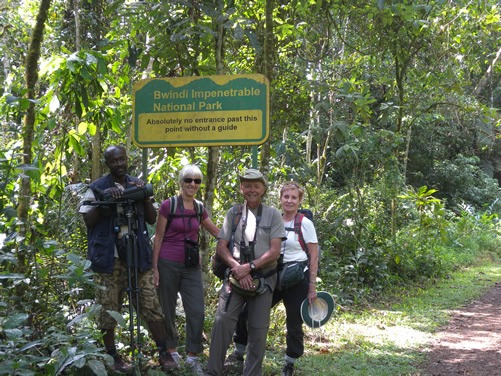 Bwindi became a national park in 1991 but has grown to become one of the few UNESCO World Heritage Sites in Uganda. The park was established to protect mountain gorillas. At the time of its formation, less than 600 mountain gorillas remained in the wild. Apart from establishing the gorilla park, Uganda also became the first country to introduce gorilla trekking. The government realized that gorilla trekking would attract tourists and raise the required funds to protect them. Tourism also brings opportunities to people living close to the park hence saving them from poachers.
Bwindi became a national park in 1991 but has grown to become one of the few UNESCO World Heritage Sites in Uganda. The park was established to protect mountain gorillas. At the time of its formation, less than 600 mountain gorillas remained in the wild. Apart from establishing the gorilla park, Uganda also became the first country to introduce gorilla trekking. The government realized that gorilla trekking would attract tourists and raise the required funds to protect them. Tourism also brings opportunities to people living close to the park hence saving them from poachers.
Because of gorilla trekking and the money raised, the total population of mountain gorillas is about 1000 in Uganda, Rwanda and the Democratic Republic of Congo. There are 52 gorilla families in Bwindi. Only 19 are habituated and open to visitors for normal gorilla trekking. There are also two that are open to the gorilla habituation experience. The rest remain wild and uncomfortable with human presence. Bwindi is a large forest with four sectors – Nkuringo, Buhoma, Rushaga and Ruhija. Each sector has its own gorilla groups. In order to track gorillas, tourists are required to acquire a gorilla permit. A gorilla permit is a document which allows one access to the gorillas. A gorilla permits costs $700 per person and can be acquired from Uganda wildlife Authority or indirectly through a local tour operator.
Gorilla trekking and permits needs to be booked in advance. One can do this with a tour operator or organize the trip as an individual. For a more comfortable experience, it is better to use a Tour operator 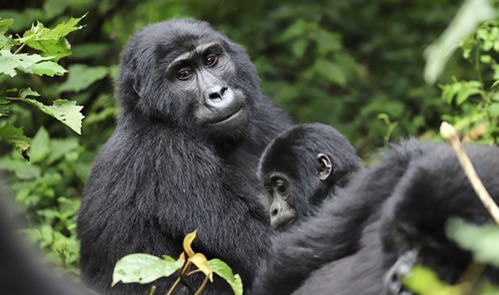 to do all the planning for you as you concentrate on visas, air tickets and showing up. A tour operator normally helps with getting the gorilla permit, providing transport and booking accommodation. Tour operators may also help you with booking international and local flights. There are many important things that you might not be aware of if you arrange the trip yourself. Tour operators can also advise on what to pack for gorilla trekking and the other activities in the park such as nature walks, birding or community encounters. These activities are usually added to the itinerary to make it more exciting and adventurous.
to do all the planning for you as you concentrate on visas, air tickets and showing up. A tour operator normally helps with getting the gorilla permit, providing transport and booking accommodation. Tour operators may also help you with booking international and local flights. There are many important things that you might not be aware of if you arrange the trip yourself. Tour operators can also advise on what to pack for gorilla trekking and the other activities in the park such as nature walks, birding or community encounters. These activities are usually added to the itinerary to make it more exciting and adventurous.
Gorilla Trekking in Bwindi Impenetrable National Park
After booking the permit and getting to the park, you should have rest and wait to start the trek early the next day. Gorilla trekking in Bwindi starts early in the morning. Visitors must arrive at the park 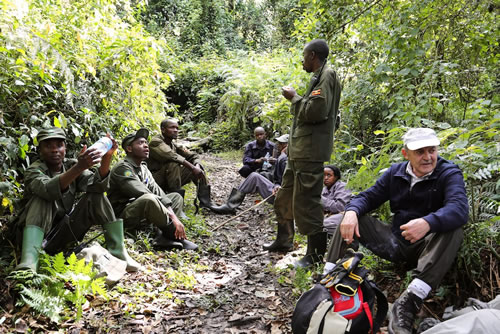 headquarter by 7:30pm. On arrival, all travelers gather in one place for the briefing at 7:30am. This briefing covers various topics including what to expect, the history of the park and information about the gorilla groups. After the briefing, your gorilla permits and passport will be verified. The allocation of gorilla groups is based on your overall level of fitness. This is determined by your age among other factors. You are free to request for an easier or harder trek. Those who have heavy luggage or cameras and wish to move with them for the trek do not need to despair. After the briefing, you will be allowed to hire a porter to help out with that. Their services cost between $10 to $15.
headquarter by 7:30pm. On arrival, all travelers gather in one place for the briefing at 7:30am. This briefing covers various topics including what to expect, the history of the park and information about the gorilla groups. After the briefing, your gorilla permits and passport will be verified. The allocation of gorilla groups is based on your overall level of fitness. This is determined by your age among other factors. You are free to request for an easier or harder trek. Those who have heavy luggage or cameras and wish to move with them for the trek do not need to despair. After the briefing, you will be allowed to hire a porter to help out with that. Their services cost between $10 to $15.
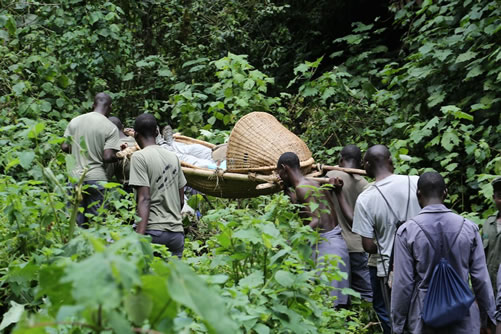 Only 8 people may track a particular gorilla group in a day. The chief Ranger will lead the team into the forest after everything has been sorted. The terrain is unpredictable in Bwindi and the level of difficulty of the hike depends on many factors. On one had is the location of the gorilla family on that day while on the other hand is the steepness of the terrain. It is recommended that you enjoy the experience by looking out for other monkeys, reptiles, butterflies and tree species. Gorilla Trekking in Bwindi can take between 2 to 6 hours depending on the gorilla group you are assigned. In all this, tourists are allowed only one hour with the primates after finding them.
Only 8 people may track a particular gorilla group in a day. The chief Ranger will lead the team into the forest after everything has been sorted. The terrain is unpredictable in Bwindi and the level of difficulty of the hike depends on many factors. On one had is the location of the gorilla family on that day while on the other hand is the steepness of the terrain. It is recommended that you enjoy the experience by looking out for other monkeys, reptiles, butterflies and tree species. Gorilla Trekking in Bwindi can take between 2 to 6 hours depending on the gorilla group you are assigned. In all this, tourists are allowed only one hour with the primates after finding them.
The first gorilla to be encountered is usually the dominant silverback. This is because he is always on the lookout for any danger to the group. The silverback will study your group and once he senses that there ![]() is no threat, you can begin your observations unhindered. Expect to find the group busy feeding or resting. The juveniles/adolescents are very playful while infants stay close to their mothers. It is important to always follow instructions of the Rangers. Never attempt to touch a gorilla even when it gets close to you. Never attempt to reach out to an infant to avoid alerting the mother the silverback. Always keep a distance of at least 7 meters away from the nearest gorilla. Stay focused so as to get the best shots of the primates.
is no threat, you can begin your observations unhindered. Expect to find the group busy feeding or resting. The juveniles/adolescents are very playful while infants stay close to their mothers. It is important to always follow instructions of the Rangers. Never attempt to touch a gorilla even when it gets close to you. Never attempt to reach out to an infant to avoid alerting the mother the silverback. Always keep a distance of at least 7 meters away from the nearest gorilla. Stay focused so as to get the best shots of the primates.
After one hour of interaction with the gorillas, the Rangers will lead travelers back to the starting point. All those who complete gorilla trekking are entitled to a certificate of completion. These certificates are one way of showing gratitude for supporting gorilla conservation activities. You can also show it off to your buddies back home and tell them that you saw the might silverback.
The cost of the Gorilla Trekking in Bwindi impenetrable National park
There is no fixed price for a gorilla trekking safari because the packages consist of different components that keep on fluctuating every now and then. However, when you get to know the components involved ![]() in a particular package, you can estimate the price. The cost of gorilla trekking in Uganda includes a gorilla permit, ground transportation, an office driver/guide, accommodation, meals, government taxes and company profits. The final cost also depends on whether you will be traveling on budget, mid-range or luxury lodges. A 1 day gorilla tour in Bwindi will cost $970 per person for two travelers on budget. The 2 days Uganda gorilla tour costs $1150 per person for budget travel while the 3 days Bwindi gorilla tour costs $1350 per person. Mid-range travelers pay slightly more while the Luxury travelers pay even more. The above costs exclude flights, visas and expenses that could be considered personal such as tipping staff. Many Tourists consider Uganda the best country for gorilla trekking because of the lower price for permits and sheer number of gorillas.
in a particular package, you can estimate the price. The cost of gorilla trekking in Uganda includes a gorilla permit, ground transportation, an office driver/guide, accommodation, meals, government taxes and company profits. The final cost also depends on whether you will be traveling on budget, mid-range or luxury lodges. A 1 day gorilla tour in Bwindi will cost $970 per person for two travelers on budget. The 2 days Uganda gorilla tour costs $1150 per person for budget travel while the 3 days Bwindi gorilla tour costs $1350 per person. Mid-range travelers pay slightly more while the Luxury travelers pay even more. The above costs exclude flights, visas and expenses that could be considered personal such as tipping staff. Many Tourists consider Uganda the best country for gorilla trekking because of the lower price for permits and sheer number of gorillas.
Additional information about Gorilla Trekking in Bwindi
Gorilla trekking is carried out throughout the year unless there is uncontrollable calamity or a pandemic like COvid-19 that broke out in 2020. The chances of seeing gorillas in Uganda is 98%. Though gorilla trekking is open throughout the year, many tour operators advise their clients to visit during the ![]() dry months of December to Mid-March or June to October. This is because of good weather. Because there is little rain, the roads leading to the park are passable and the forest trails have less mud. Without the heavy rains, the skies are clear and photographing the gorillas is excellent.
dry months of December to Mid-March or June to October. This is because of good weather. Because there is little rain, the roads leading to the park are passable and the forest trails have less mud. Without the heavy rains, the skies are clear and photographing the gorillas is excellent.
It is important to book gorilla permits in advance especially if you plan to visit during the peak season. If you don’t, you run the risk missing our or getting permits for less exciting sectors. Gorilla permits are issued on a first come first serve basis. If you are within Uganda, you can acquire the permit at the Uganda Wildlife Authority offices in Kampala. International travelers should apply for the permits through a tour operator. There are other aspects of the tour that only a tour operator can organize. You might want to read an article about gorilla permit discounts in Uganda.
Other activities in Bwindi Forest (Apart from gorilla trekking)
Batwa Cultural Experience: The Batwa pygmies are an indigenous group of people who had lived within Bwindi forest for over 2,000 years. The Batwa lived as fruit gatherers and hunters but their ![]() comfortable life in the forest was cut short when Bwindi was established as a national park. Suddenly they had to embrace a new way of living away from the security in the forest. They also had to deal with tribes they had avoided for thousands of years. Unable to compete in a modern world, the Batwa pygmies have been marginalized by other tribal groups. To make matters worse, the Batwa failed to adapt to a new way of life outside the safety of Bwindi forest. Visiting the Batwa pygmies is an opportunity to learn about the negative impact of wildlife conservation if not managed well. While with the Batwa, you will hear their stories of life in the forest and nostalgia for the life they lost. They will entertain through music, dance and story-telling.
comfortable life in the forest was cut short when Bwindi was established as a national park. Suddenly they had to embrace a new way of living away from the security in the forest. They also had to deal with tribes they had avoided for thousands of years. Unable to compete in a modern world, the Batwa pygmies have been marginalized by other tribal groups. To make matters worse, the Batwa failed to adapt to a new way of life outside the safety of Bwindi forest. Visiting the Batwa pygmies is an opportunity to learn about the negative impact of wildlife conservation if not managed well. While with the Batwa, you will hear their stories of life in the forest and nostalgia for the life they lost. They will entertain through music, dance and story-telling.
Tracking smaller primates and mammals: Apart from gorillas and chimpanzees, Bwindi Impenetrable National Park also has red-tailed monkeys, vevert monkeys, blue monkeys, colobus 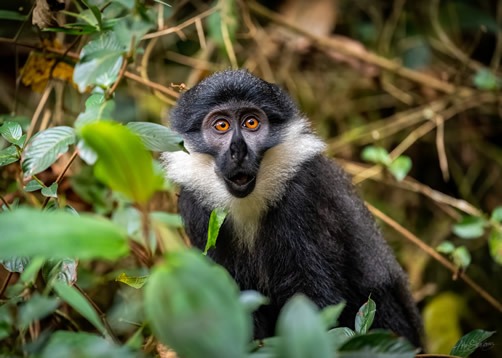 monkeys and bush babies. Bwindi may not be the best place to observe chimps but they can be seen along with other smaller primates while in the forest. Bwindi is also home to forest hogs, duikers, jackals, bats, African forest elephants and leopards.
monkeys and bush babies. Bwindi may not be the best place to observe chimps but they can be seen along with other smaller primates while in the forest. Bwindi is also home to forest hogs, duikers, jackals, bats, African forest elephants and leopards.
Birding: In 2010, Bwindi was voted as one of the top ten birding destinations in Africa. This vast forest has over 330 bird species of which 23 are endemic to the Albertine rift. Birds like crowned hornbill, African harrier hawk, African green pigeon ![]() and giant kingfisher can be spotted while tracking gorillas or on a nature walk. Bird watching in Uganda is therefore incomplete without visiting Bwindi Impenetrable National Park.
and giant kingfisher can be spotted while tracking gorillas or on a nature walk. Bird watching in Uganda is therefore incomplete without visiting Bwindi Impenetrable National Park.
Nature walks: This is one of the most interesting and exciting tourism activities in the park. Bwindi impenetrable national park has eye-catching natural features like waterfalls, streams, rivers, valleys and scenic hills. These amazing features can be discovered while on a nature walk. The nature walk also takes you to see forest mammals, reptiles, bats, butterflies and different types of monkeys.
Accommodation during gorilla tracking in Bwindi
One of the important things to consider while planning for gorilla trekking in Bwindi is where to stay. Bwindi impenetrable national park has a variety of accommodation facilities in the four different sectors. These vary from luxury to budget ones and it is all up to the traveler to choose the right accommodation under the guidance of a tour operator. Some of the lodges are: –
Volcanoes Safaris Bwindi Lodge: This is one of the best and most expensive luxury lodges in Bwindi Impenetrable National Park. It overlooks the vast forest of Bwindi and is located close to the ![]() starting point for gorilla trekking. Volcanoes Bwindi lodge is a super luxury lodge designed for those who can afford the best. It has 9 luxury bandas and an award winning bar commonly known as Bwindi bar.
starting point for gorilla trekking. Volcanoes Bwindi lodge is a super luxury lodge designed for those who can afford the best. It has 9 luxury bandas and an award winning bar commonly known as Bwindi bar.
Buhoma Community Campsite: As one of the popular budget accommodation facilities in Bwindi, Buhoma Community Campsite receives many visitors interested in gorilla trekking but on a budget. Despite being categorized as budget, the rooms are self-contained, comfortable and of good quality.
Clouds Mountain Gorilla lodge: Another amazing lodge for those who want the best. The lodge offers self-contained cottages that are built to near perfection. Clouds Mountain Gorilla Lodge was designed using natural materials and furnished with African art.
![]() Gorilla Forest Camp: Owned by and international company known as Sanctuary Retreats, this is arguably the most expensive lodge in Bwindi. It has only 7 permanent luxury tents. Gorilla Forest Camp is special not only because of the high quality of services but also because gorillas frequently visit the compound. If you stay for about 3 days, you are most likely going to see the primates roaming in the compound.
Gorilla Forest Camp: Owned by and international company known as Sanctuary Retreats, this is arguably the most expensive lodge in Bwindi. It has only 7 permanent luxury tents. Gorilla Forest Camp is special not only because of the high quality of services but also because gorillas frequently visit the compound. If you stay for about 3 days, you are most likely going to see the primates roaming in the compound.
Mahogany Springs: Crafted with tough mahogany wood, Mahogany Springs is one of the best luxury lodges in Bwindi forest. It is built facing River Munyanga and the vast forest hence offering amazing views of the forest.


